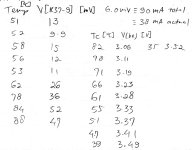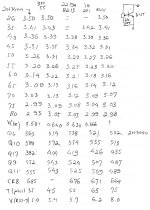This ancient 35 kg monster amp came back after a repair involving several blown transistors in the output stage including Q4. Now this is a V(be) multiplier that has an unusual high voltage of 3.5 V across it. I had replaced it with a 2N2219A from my tray only to have the owner complain about the right side getting blistering hot and finally cutting out due to the thermal sensor. Sure enough, bias current went through the roof with even a small load (3 W). See my notes:

While the V(be) multiplier did its job it clearly wasn't sufficient. I set up a test jig and compared the few TO-5 transistors left in my tray:

Only a NOS 2N3444 with long legs, even more vintage than the amp itself (1968) seemed to have a better response. When I swapped it out the bias behaved as can be seen in the lower half of the page where I measured several V(be) voltages at different temperatures. I heated the heatsink with an external source (TO-3P power zener). When putting everything back it behaved nicely:

The rectangle is a small black patch needed for the FLIR to measure the temperature of the bare metal.
The schematic is full of errors, this version has sorted most of 'em. Note that Q4 is marked "SIM" in the manual which means that it is specially selected. Well, this one certainly is!
I hope this is of use for someone.

While the V(be) multiplier did its job it clearly wasn't sufficient. I set up a test jig and compared the few TO-5 transistors left in my tray:

Only a NOS 2N3444 with long legs, even more vintage than the amp itself (1968) seemed to have a better response. When I swapped it out the bias behaved as can be seen in the lower half of the page where I measured several V(be) voltages at different temperatures. I heated the heatsink with an external source (TO-3P power zener). When putting everything back it behaved nicely:
The rectangle is a small black patch needed for the FLIR to measure the temperature of the bare metal.
The schematic is full of errors, this version has sorted most of 'em. Note that Q4 is marked "SIM" in the manual which means that it is specially selected. Well, this one certainly is!
I hope this is of use for someone.
Attachments
That type of amplifier is supposed to be biased class B with zero bias in the outputs, with heavy bias in the drivers due to the low value of R30. The vbe multipliers and often the compensation need addressing in order to run AB. Large-die transistors are needed if the thermal comp transistor needs a low vbe. Darlingtons (low voltage types without the internal resistors) or CFPs are often used to get the Vbe down and multiplication factor up. When i need a low vbe value at the usual 6-10 mA VAS current I go for the D44H8. 50 watt transistor that keeps its beta high at 1 or 2 volts. The vbe transistor needs high gain too. If it didn’t a TIP41 would work.
This issue is specific for this amp because of its unusual design. I got caught out with it and provide this info so others don't. Dunno what the h(FE) of my vintage 2N3444 is but it works like a charm.
The unusual front end has little to do with the output stage bias. That output stage as quite common at the time - everybody copied BGW Including Bose. Most of them biased it class B to avoid the runaway. Using a lower Vbe transistor for the thermal sense resulted in more “vbe multiplication” and a larger negative temperature coefficient in the bias network, which is needed to prevent runaway here. Most transistors with the the usual .65V result in undercompensation of the bias. When Crown and Phase Linear set the bias voltage to .35 volts at the output tranny vbe, it has room to go up before things go south.
I'm not talking about the input stage. The output stage is unusual because it uses darlingtons as output transistors plus the quasi-complementary driver pair. Then Bose added an extra diode to add one more diode drop (D8). The thermal runaway was caused by Q4 having an incorrect V(be) resulting in an undercompensated bias. This must be the reason Bose needed a specially selected device ("SIM" as per manual). The NOS 2N3444 put things right. Thermal runaway is gone completely.The unusual front end has little to do with the output stage bias.
That output stage is NOT unusual at all. It’s a standard QC triple with the Baxandall diode. And paralleled outputs. Back in the 70’s, every amp with 60 to 80-ish volt dual rails that didn’t resort to stacking high gain low voltage output trannies in series did it this way. With varying degrees of success. It was most common to see the outputs run fully class B, so the Vbe multiplier or diode bias stack could be a bit sloppy and still work.
The front end is unusual - with a full differential input VFA inside that op amp feedback loop. Others either used CFAs, or no local feedback at all, inside the outer loop.
The front end is unusual - with a full differential input VFA inside that op amp feedback loop. Others either used CFAs, or no local feedback at all, inside the outer loop.